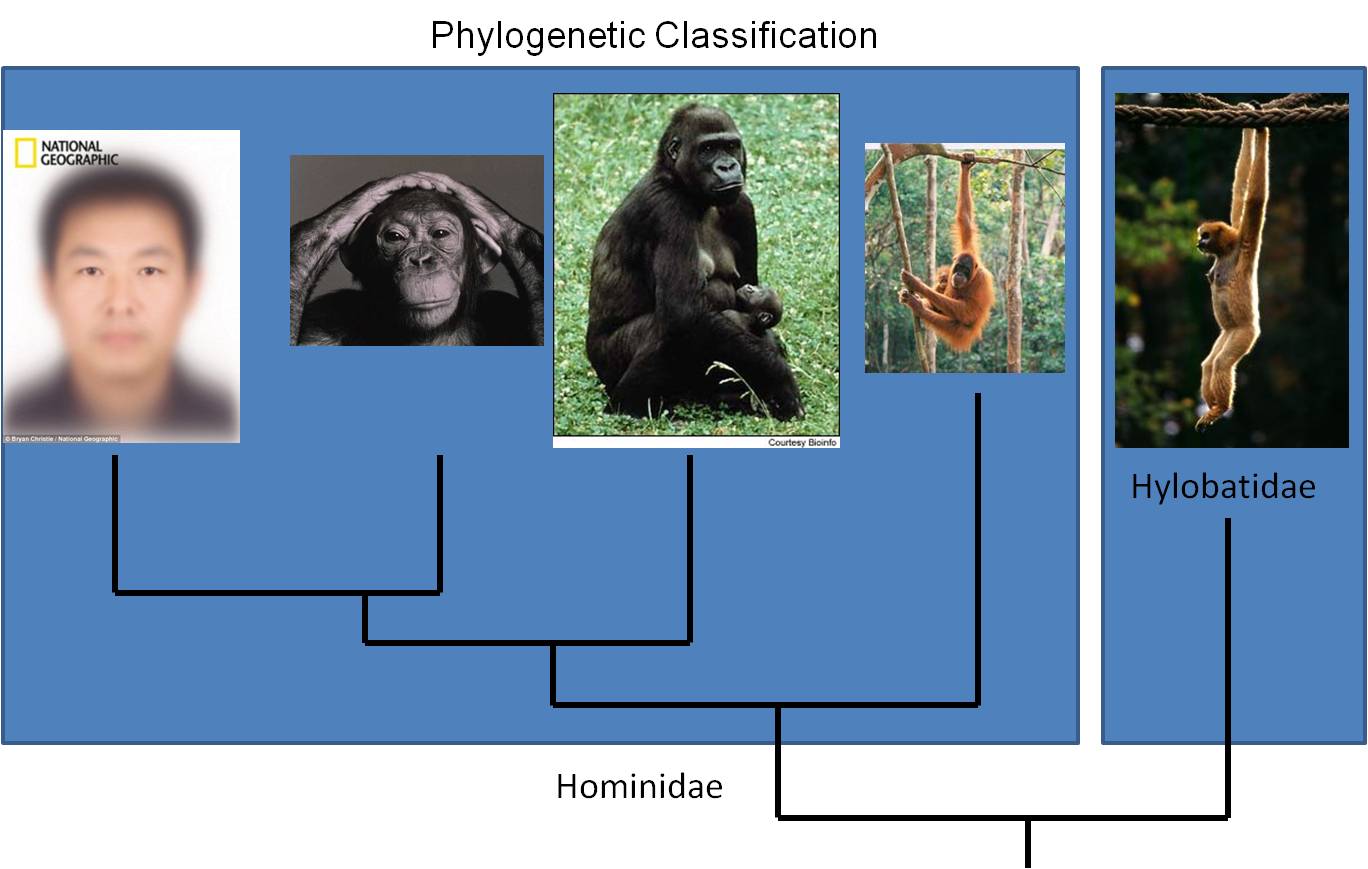 IV.
The Domain Eukarya
IV.
The Domain Eukarya  IV.
The Domain Eukarya
IV.
The Domain Eukarya 1. Introduction:
Human evolution provides great examples of many of the themes that we have been discussing in this last unit, including the themes of classification vs. phylogenetics, developmental genetics and evolution, and the sequence of innovation, radiation, and competitive contraction.
Humans are primates; primates are mammals with grasping hands and forward facing eyes. Humans are further classified in the superfamily Hominoidea - generally equivalent to the term "apes". These are primates that lack tails, and also include the gibbons, orangutan, gorillas, and chimpanzees. (Some macaques lack tails, also, but are not apes.) Previous to recent genetic analyses, apes were classified in families (taxonomic categories with the suffix "-idae") like this: Hominidae (humans), Pongidae (chimps, gorillas, and orangutans), and Hylobatidae (gibbons). Now, given the knowledge that chimps and gorillas are more closely related to humans than to orangutans, the phylogeny is described as follows: Hominidae (humans, chimps, gorillas, orangutan), and Hylobatidae (gibbons).
Although the degree of genetic difference reported between humans and chimpanzees tends to vary depending on the genomic regions compared, in general there is about a 1-4% difference in DNA sequence between chimpanzee species and humans. In many respects, this seems like a remarkably SMALL difference - especially considering the dramatic differences between these species in morphology and behavior.
So, that begs the following question: "can we really explain the differences in morphology and behavior with only a 1-4% change in DNA?" In short, can this small amount of genetic change cause the differences we see? To get a handle on whether this is possible, we should describe the patterns more completely - how do these species differ morphologically and behaviorally, and does that suggest a particular genetic explanation?
2. Patterns
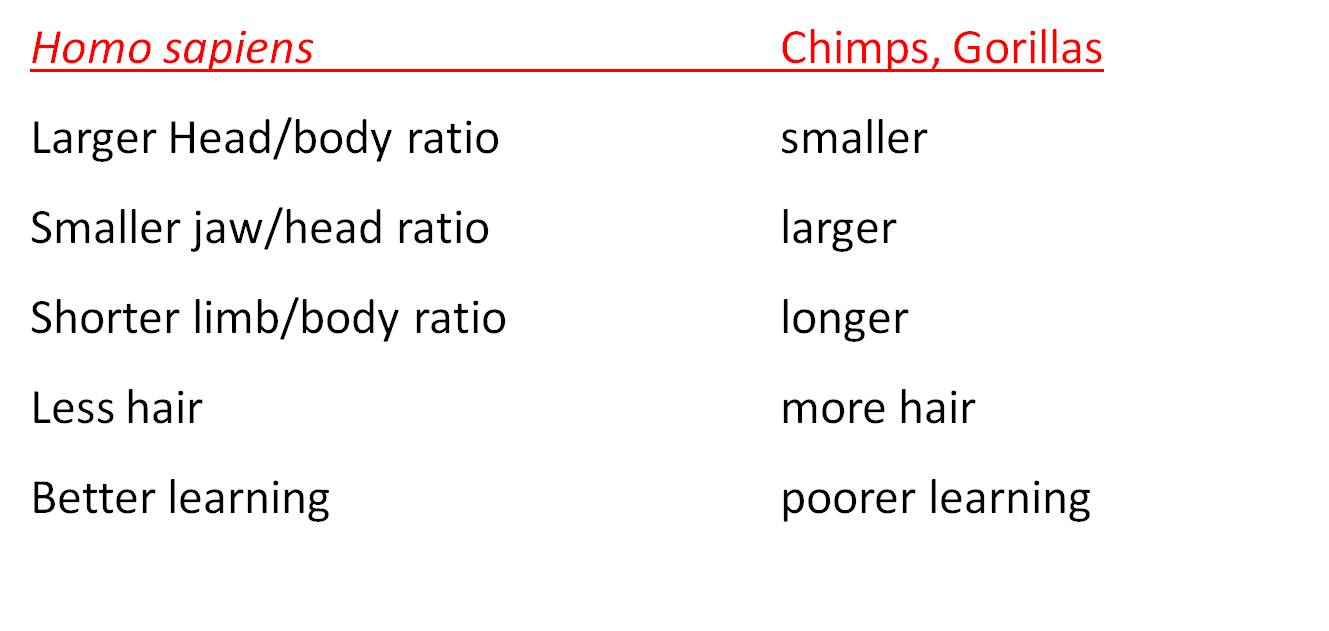 a.
Morphological and Behavioral
a.
Morphological and Behavioral
Humans differ from chimps and gorillas in several obvious morphological and behavioral ways. Morphologically, humans have a larger head-to-body ratio, a small jaw-to-head ratio, and shorter arms in proportion to their body. Humans also have less hair. And of course, humans are bipedal. Behaviorally, the differences are even more extreme. Humans are much better at learning - particularly from other humans. Humans use this knowledge to solve new problems, and can put different pieces of knowledge together. Many other species use tools, but humans build tools to build other tools. In short, we have created elaborate technologies, whereas the culmination of chimp technology is to remove the leaves from a stick to probe termite mounds for termites.
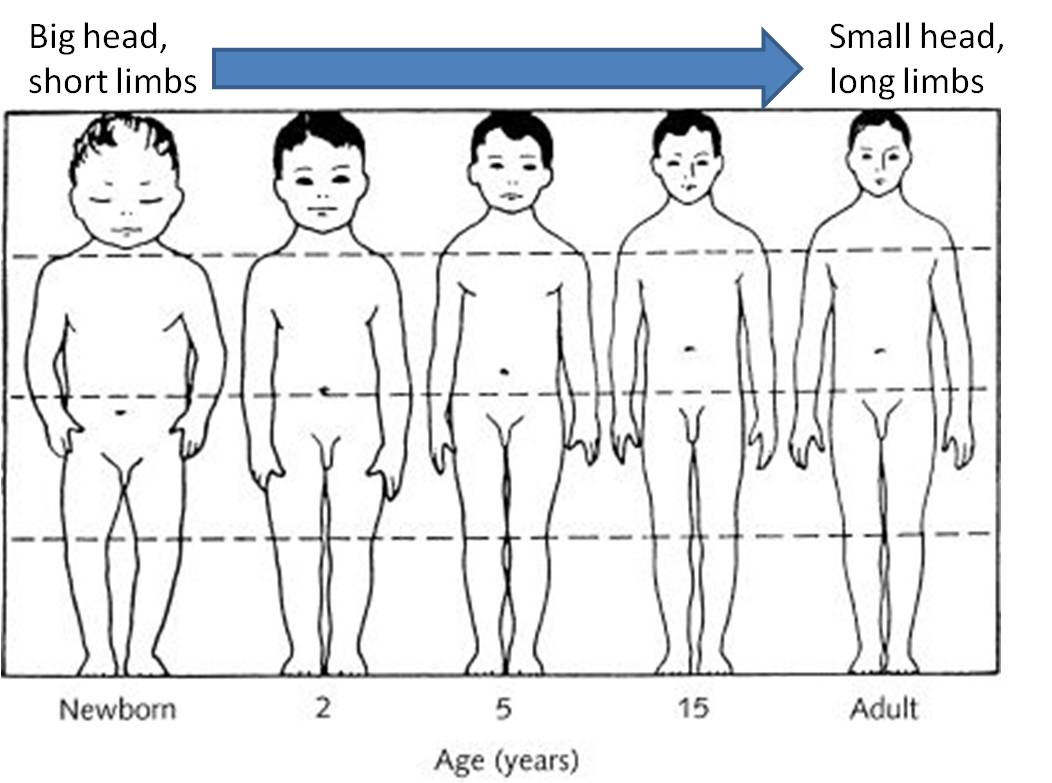 Although
this may seem like an unbridgeable, qualitative difference, they are actually
points along a continuum of morphological and behavioral development. Even within
a single species of primate, like Homo sapiens, we see just as dramatic
a change in morphology and development play out along the trajectory of a single
person's lifetime. Consider the morphological and behavioral differences between
a newborn infant and an adult human. The infant has a large head-to-body ratio,
a small jaw-to-head ratio, and short limbs in proportion to the rest of the
body. Babies have less hair than adults, as well. Likewise, babies are incapable
of the complex behaviors of speech, logic, reasoning, tool-using, and tool-making
that adults can perform. But children are really good at learning. Indeed, all
primates go through these trends during development. It is very interesting
that these are the same trends that distinguish humans from other primates.
In short, these patterns suggest that the genetic difference between humans
and chimps may be in developmental genes - or the genes that regulate the activity
of the developmental changes that occur from infacnt to adult. Humans grow to
reproductive adulthood, but maintain the juvenile conditions of body proportion
and behavioral flexibility. As we know, a small change in developmental genes
can cause a big difference in the final phenotype of the organism. So, the 1-4%
difference between humans and chimps could cause the changes we see, if those
genetic differences are in developmental genes. The way the species differ,
in a manner correlating with developmental changes in primates, is consistent
with this idea.
Although
this may seem like an unbridgeable, qualitative difference, they are actually
points along a continuum of morphological and behavioral development. Even within
a single species of primate, like Homo sapiens, we see just as dramatic
a change in morphology and development play out along the trajectory of a single
person's lifetime. Consider the morphological and behavioral differences between
a newborn infant and an adult human. The infant has a large head-to-body ratio,
a small jaw-to-head ratio, and short limbs in proportion to the rest of the
body. Babies have less hair than adults, as well. Likewise, babies are incapable
of the complex behaviors of speech, logic, reasoning, tool-using, and tool-making
that adults can perform. But children are really good at learning. Indeed, all
primates go through these trends during development. It is very interesting
that these are the same trends that distinguish humans from other primates.
In short, these patterns suggest that the genetic difference between humans
and chimps may be in developmental genes - or the genes that regulate the activity
of the developmental changes that occur from infacnt to adult. Humans grow to
reproductive adulthood, but maintain the juvenile conditions of body proportion
and behavioral flexibility. As we know, a small change in developmental genes
can cause a big difference in the final phenotype of the organism. So, the 1-4%
difference between humans and chimps could cause the changes we see, if those
genetic differences are in developmental genes. The way the species differ,
in a manner correlating with developmental changes in primates, is consistent
with this idea.
b. Genetic
Now that the human and chimp genomes have been sequenced, scientists are seeing where the differences are. One difference is in the HAR-1 gene, which codes for an RNA molecule. This RNA is not translated into a protein, so it is probably a regulatory RNA. Although only 2 bases differ between chimps and chickens, 18 differences occur between humans and chimps. This is much greater than a random process of drift can explain; it is likely that these differences accumulated rapidly in response to selection. Indeed, "HAR" stands for "human accelerated region", describing the rapid change that occurred in this region since the divergence of humans and chimps. Even more intriguing is that the gene for this RNA lies near coding sequences for proteins that influence neural development. So, we may be focusing in on the genes responsible for the rapid developmental shift in neural development that characterize human evolution.
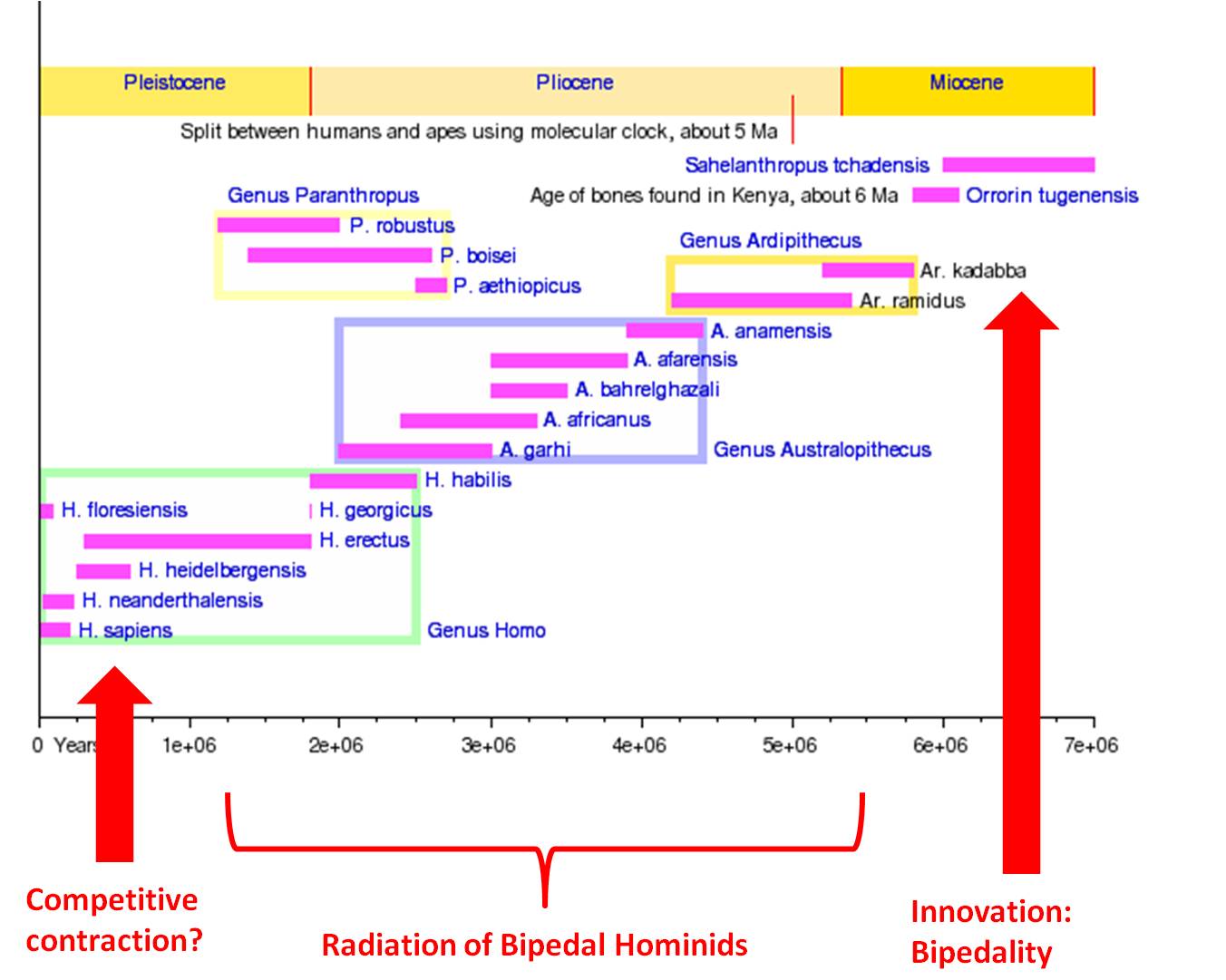 c.
Fossils
c.
Fossils
Because humans are a rather recent evolutionary product, we have a rich fossil history; there has been little time (in geological terms!) for fossils to be destroyed under pressure or recycled by tectonic activity. The major differences that distinguish our lineage from chimps are a large brain and a bipedal gait. These differences did not evolve simultaneously; rather, the fossil record shows us that bipedality evolve much earlier, with a rapid expansion in cranial volume occurring millions of years later. Two questions emerge when we consider the evolution and divergence in any group. Are their potential common acestors to the species, and are their intermediate fossils mapping the transitions? The rich fossil record of early hominids provides answers to both these questions. Sahelanthropus tchadensis, found in 2001 in Chad, dates to 6-7 mya and may be a common ancestor of the human-chimp clade. Although only a skull exists, it has a primitive mixture of characteristics. Transitional fossil abound, as well. Ardepithecus ramidus, discovered in 1994 but finally described in 2009, is a very complete fossil dating to about 4.5 mya, with critical skeletal elements of the hip, leg, arms, skull, and hands and feet. From the architecture of the skeleton, paleontologists have concluded that this species was typically arboreal (large grasping feet), but was also facultatively bipedal - perhaps walking between trees used for nesting. It is a beautiful intermediate, with both arboreal and bipedal characteristics. More recent fossils (4.5 and 4.0 mya) placed in the genus Australopithecus are exclusively bipedal. A notable species, Australopithecus afarensis, provides striking evidence of this transition. The hips are bowl-like, the femora articulate with the tibia at angles indicative of bipedality, and footprints dating to this period show that these organisms walked erect. They have very small, chimp-sized brains, however; with cranial volumes only 25% the size of modern humans. However, even the skull does show some derived traits, such as smaller canines and a short face (not a long snout like mature chimps).
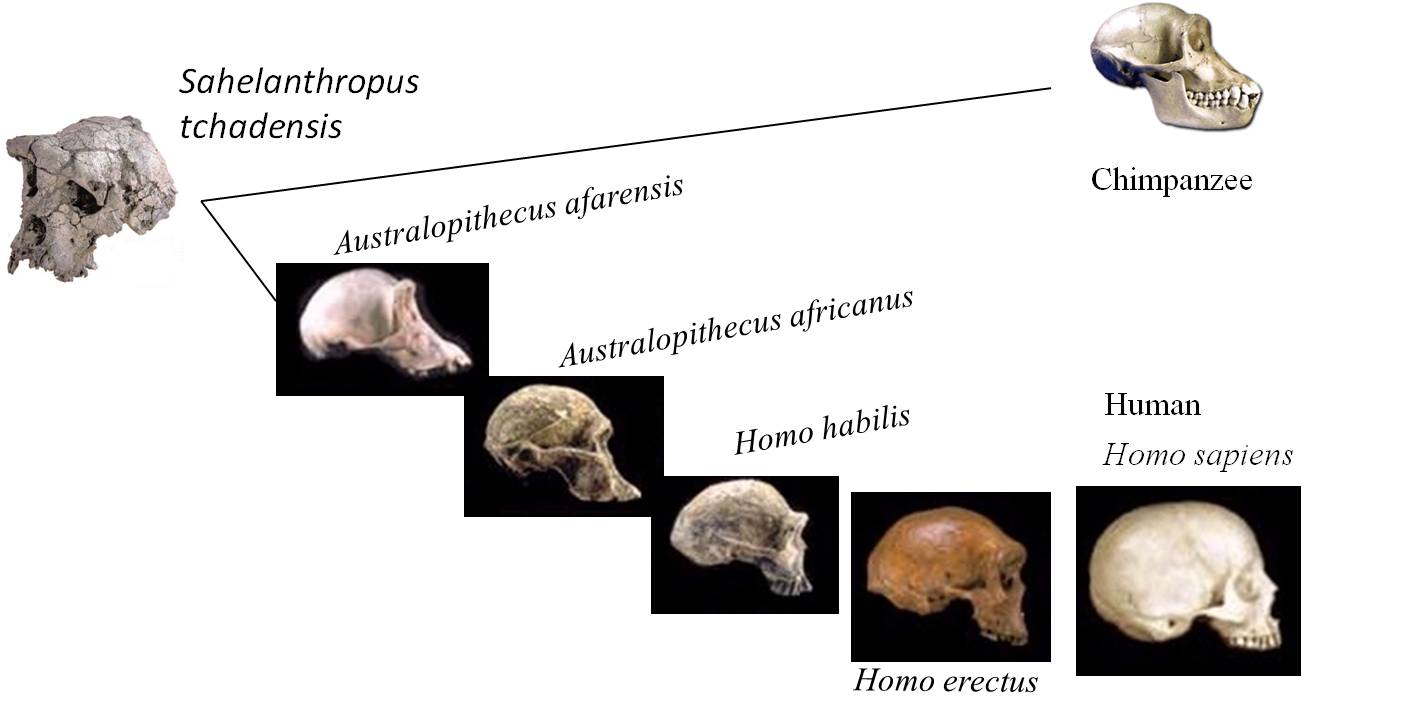 After
bipedality evolved, there was a radiation of bipedal forms. Several species,
like A. bahrelgahzali, A. sediba, and Kenyanthropus platyops
form a clade that may represent separate species or simply different subspecies
of A. australopithecus. This radiation, however, seemed to stabilize
in two major lineages: a light--bodied, graceful clade established by Australopithecus
africanus, and a heavy-bodied, more "robust" lineage established
by Paranthropus aethiopicus. About 2 mya, there were these two divergent
lineages of bipedal hominids in the east African savannah. The robust lineage
produced P. bosei and P. robustus, but went extinct about
1.25 mya; perhaps due to competitive effects from the the other bipedal groups.
The light-bodied lineage leads to the genus Homo, from A. garhi
to H. habilis, H. erectus, and our own species, H. sapiens.
Cranial expansion occurs in the genus Homo, 2-3 my after bipedality
evolved. Even within the genus Homo, there are several species that
may have lived contemporaneously. H. erectus was the first hominid
species to leave Africa, radiatating into Europe and Asia. Back in Africa, ancestral
populations of H. heidelbergensis evolved. Some populations left Africa
and diverged into H. neanderthalensis; other populations remained in
Africa and evolved into H. sapiens. Populations of H. sapiens
left Africa later, and may have encountered and displaced H. neanderthalensis
in Europe.
After
bipedality evolved, there was a radiation of bipedal forms. Several species,
like A. bahrelgahzali, A. sediba, and Kenyanthropus platyops
form a clade that may represent separate species or simply different subspecies
of A. australopithecus. This radiation, however, seemed to stabilize
in two major lineages: a light--bodied, graceful clade established by Australopithecus
africanus, and a heavy-bodied, more "robust" lineage established
by Paranthropus aethiopicus. About 2 mya, there were these two divergent
lineages of bipedal hominids in the east African savannah. The robust lineage
produced P. bosei and P. robustus, but went extinct about
1.25 mya; perhaps due to competitive effects from the the other bipedal groups.
The light-bodied lineage leads to the genus Homo, from A. garhi
to H. habilis, H. erectus, and our own species, H. sapiens.
Cranial expansion occurs in the genus Homo, 2-3 my after bipedality
evolved. Even within the genus Homo, there are several species that
may have lived contemporaneously. H. erectus was the first hominid
species to leave Africa, radiatating into Europe and Asia. Back in Africa, ancestral
populations of H. heidelbergensis evolved. Some populations left Africa
and diverged into H. neanderthalensis; other populations remained in
Africa and evolved into H. sapiens. Populations of H. sapiens
left Africa later, and may have encountered and displaced H. neanderthalensis
in Europe.
So, within our own evolutionary history, we see the patterns of innovation (bipedality and later, brain size), radiation, and (competitive?) contraction.
Study Questions:
1) How do humans and chimps differ morphologically?
2) Describe the developmental changes that occur in the growth of a person, and describe how this relates to differences between humans and chimps.
3) What genes might be responsible for the differences beween humans and chimps? Is there any genetic evidence that supports this hypothesis?
4) What is significant about Ardipithecus ramidus?
5) Place these species in the correct temporal order (old to recent): Homo erectus, H. habilis, H. sapiens, A. africanus, A. afarensis.